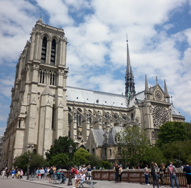Key areas for any organisation to review regularly are risk assessment, planning and implementation, information and intelligence and training, writes the security company Pilgrims Group.
One hundred and thirty people are reported dead after terror attacks in Paris on Friday evening, November 13. Mark Rowe considers a security issue little covered so far in the aftermath – the Euro 2016 football championships in France.
If you left work at 5pm on Friday, November 13, and returned to your desk on Monday, November 16, everything may look the same, but it’s not. If you are a corporate security head, executives may well have asked you in between time about security, if they or the organisation more generally has business in Paris. And unless you are not bothered about keeping your job, the executives would have received a reply.
That reply may well have been the same as after the Charlie Hebdo attack; terrorist bombs in Bangkok; and other events. A calming reply – with reason – that risks are assessed and measures are in place. Such an attack is a risk of doing business, the same as being in a traffic accident or falling ill with a tropical disease. You could also point to the Foreign Office online advice; and if you are an American company, signed up to the State Department Overseas Security Advisory Council (OSAC) website, for their diplomatic advice, similar to the FO’s.
The Met Police Commissioner Sir Bernard Hogan-Howe was correct to speak in terms of terrorist ‘tactics’. Instead of bombs as against Madrid trains in 2004 and London Tube trains and a bus on July 7, 2005, or the failed attempts on Tiger Tiger in London and Glasgow Airport in 2007; now gunmen drive around and shooting at and in restaurants and a concert venue. Even this tactic, a sort of urban warfare, or ‘co-ordinated firearms attacks’ was seen in Mumbai in 2008 (as Prime Minister David Cameron recalled in a statement).
Little, relatively little, was said over the weekend of the attack on the Stade de France where France and Germany were playing an international football friendly; a bomb was reportedly exploded outside the stadium, the attacker having sought to enter. Security worked.
In all of these cases, the threat, acknowledged officially – in terms of ‘crowded places’ holds good, whether mitigating against vehicle-borne devices or suicide bombers on foot. The response has to be ‘alert but not alarmed’, again not a new phrase, as the former senior counter-terror police man Chris Phillips was saying on BBC radio on Saturday. Likewise David Cameron spoke of learning lessons, although inevitably there’s always differing points of view.
Little was said of the Stade de France compared with the indiscriminate killing in the tenth and 11th arrondissements partly because of the nature of media reporting. After the attacks, the crowd dispersed from the stadium, to their homes, difficult for the media to reach, compared with the more central districts, that both saw the violence and that hosted the impromptu (and photogenic, more photogenic and accessible than an empty stadium) memorials.
One of the French heads of security for Euro 2016 was a speaker at the Counter Terror Expo in London in April, and was featured in the June print issue of Professional Security. While he made plain he understood the range of threats to the football tournament, and while there is the example of the London Olympics held entirely successfully despite a high terror threat, London 2012 did not have in November 2011 several gunmen killing 132 people in the city.
The French President Francois Hollande spoke in terms of ‘guerre’; war. David Cameron spoke bluntly of a ‘death cult’. It is ironic that France, like Britain, has an arsenal that could kill tens, if not hundreds, of millions of people, and yet it cannot guarantee to protect its citizens against a handful of gunmen. Asymmetrical warfare indeed.
Just as the world had to wait after 9-11 to see if terrorists could and would send more suicide-piloted aircraft into skyscrapers, so we have to see whether the November 13, 2015 attackers are outlaws and freaks; or the extreme tip of an iceberg of fund-raisers, recruiters and sympathisers; or, like Maoist guerrilla fighters, fish able to swim in a sea. We know what resources we can deploy against the terrorists, and what we want to achieve – continued business as normal; we continue to see what the terrorists can deploy, and what terror they can achieve.
Crucial for the Bolsheviks in 1917 was capture of territory – Russia – and their ability to fend off what we can now see were unco-ordinated and less than full-blooded military efforts to crush it, but serious enough to give the Bolsheviks a grievance. While we cannot compare different historical times, Islamic State has one other asset, besides a ‘state’ in parts of Iraq and Syria; the internet, that enables it to recruit and radicalise and raise money, anywhere with a computer. If, as President Hollande, said, this is a war – which is itself a granting of statehood to Islamic State – it is a war with an infinite number of potential battle-fronts, from the university campus PC to the turnstiles of Wembley.
– Flags are to fly at half-mast on Whitehall government buildings as part of a minute’s silence on Monday, November 16.
Pictured: Notre Dame.










